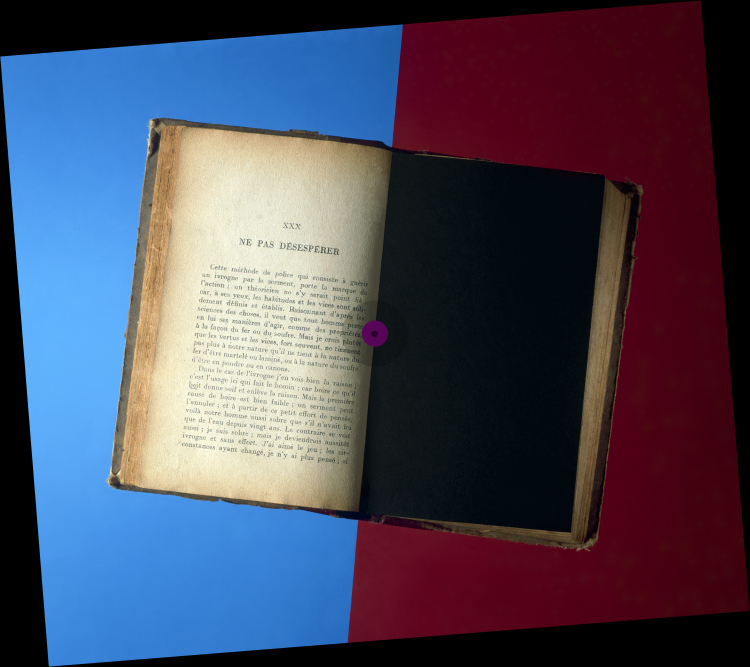Alain, Propos sur le bonheur
80 x 90 cm - 2013

Action paradoxale
Pour Alain, il ne faut pas attendre le bonheur. Jamais. Il faut le faire, agir pour l’obtenir. Le philosophe rationaliste affirme la préséance d’une volonté claire d’être heureux sur l’imagination qui nous fait divaguer. C’est donc une philosophie de l’action, chevillée au réel, qu’il propose pour combattre les passions qui réduisent notre faculté de jugement. « Je tiens qu’un des secrets du bonheur, c’est d’être indifférent à sa propre humeur. », dit-il. D’où viennent ces passions qu’alimente notre tendance à divaguer ? Des tumultes du corps, affirme Alain à la suite de Descartes pour qui des phénomènes physiologiques déter- minent notre imagination. Esprit de raison sur fond bleu, dans la lumière. Sentiments passionnés sur fond rouge assombri où la page à venir est faite d’obscurité totale. Fixée à un axe central, la composition photographique subit la gravité que confèrent teintes et couleurs. Le mouvement apparaît mécanique pour souligner le caractère déterminant de l’action dans la pensée d’Alain. La composition montre que la clarté donne assez de poids à l’optimisme pour contrebalancer l’ombre. Quelles que soient les difficultés de vivre, le volontarisme d’Alain ferait donc pencher le livre en sa faveur ? La question est posée et l’inter- rogation apparaît sous la forme d’un espace noir dans lequel la composition rouge et bleue balance. La biographie d’Alain n’est d’ailleurs pas dénuée de paradoxes. Pacifiste et anti- fasciste dans l’entre-deux guerres, sa force morale déclinera à la fin d’une existence attristée par la maladie. Jusqu’à faire très piteusement l’aveu de velléités antisémites dont il ne parvient pas à se débarrasser. Comme pour démontrer a contrario la véracité de sa théorie du bonheur dès lors qu’une trop grande faiblesse, empêchant d’agir, donne libre cours à l’humeur et l’erreur. Il est fatal que pour représenter en rouge et bleu son idée du bonheur, il ait fallu la contrainte d’un fond noir.
Paradoxical Action
For Alain, one should not wait for happiness. Never. You have to do it, act to obtain it. The rationalist philosopher affirms the precedence of a clear will to be happy over the imagination that makes us ramble. It is therefore a philosophy of action, rooted in reality, that he proposes to combat the passions that reduce our faculty of judgement. “I hold that one of the secrets of happiness is to be indifferent to one’s own mood”, he says. Where do these passions come from that feed our tendency to ramble? From the tumults of the body, says Alain, following Descartes, for whom physiological phenomena determine our imagination. The spirit of reason against a blue background, in the light. Passionate feelings against a darkened red background where the page to come is made of total darkness. Fixed to a central axis, the photographic composition is subject to the gravity conferred by the colours and tints. The movement appears mechanical to underline the decisive character of the action in Alain’s thinking. The composition reveals that clarity gives sufficient weight to optimism to counterbalance the shadow. Whatever the difficulties of living, Alain’s voluntarism would therefore tip the book in his favour? The question is posed and the interrogation appears as a black space in which the red and blue composition are in equilibrium. Alain’s biography is not without its paradoxes. A pacifist and anti-fascist between the wars, his moral strength declined at the end of a life saddened by illness. He even pitifully confessed to anti- Semitic tendencies that he could not rid himself of. As if to demonstrate the truth of his theory of happiness, when too much weakness, preventing action, gives rein to whim and error. Representing his idea of happiness in red and blue, a black background was compelled. >>> Back